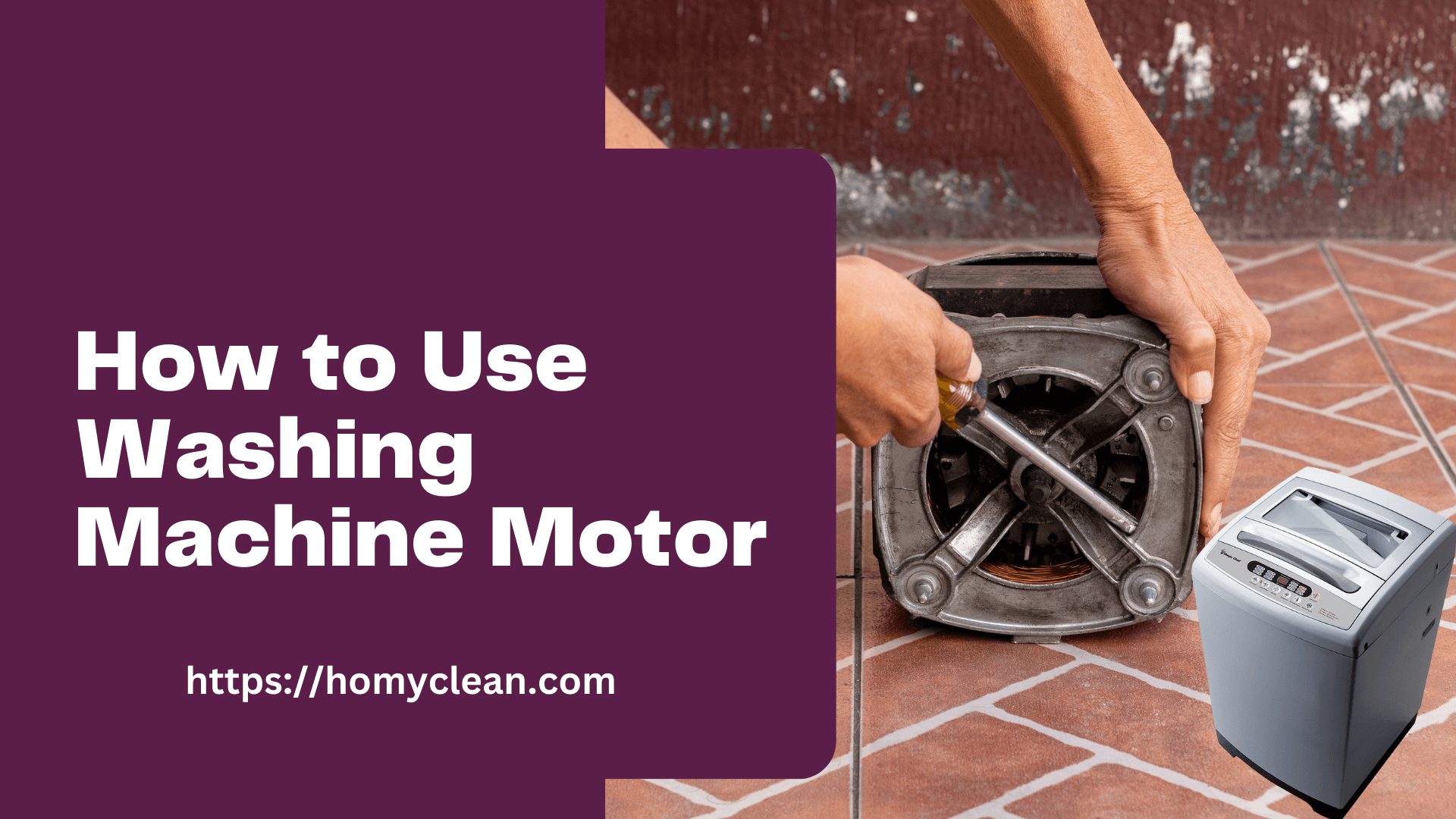Washing machine motors are essential components that power the drum and facilitate the washing process. Understanding how to use washing machine motor correctly ensures efficient and effective laundry cleaning. This article will provide a step-by-step guide to adequately using a washing machine motor.
Components of a Washing Machine Motor
A typical washing machine motor comprises the following components:
- Motor Drive Belt: Transfers the motors rotational energy to the drum.
- Control Panel: Select different wash cycles, water levels, and temperatures.
- Timer: Controls the duration of the wash cycle.
- Drain Pump: Removes water from the machine during the drainage process.
- Agitator or Pulsator: Creates the agitation for cleaning clothes.
Which Safety Precautions Should I Consider Before Using the Washing Machine Motor
Before operating the washing machine motor, ensure you follow these safety precautions:
- Read the user manual provided by the manufacturer for specific instructions related to your washing machine model.
- Make sure something properly ground the power source to prevent electrical hazards.
- Keep the machine away from water sources to avoid electrical shocks.
- Avoid overloading the machine to prevent damage to the motor and other components.
Step-by-Step Guide How to Use Washing Machine Motor
Follow these steps to use the washing machine motor effectively:
Step 1: Power Connection
Plug the washing machine into a properly grounded electrical outlet. Ensure they securely connected the power cord to the machine and the outlet.
Step 2: Selecting the Wash Cycle
Refer to the control panel on your washing machine to select the wash cycle. Standard options include “Normal,” “Delicate,” “Heavy Duty,” and “Quick Wash.” Choose the cycle that best suits your laundry requirements.
Step 3: Loading the Laundry
Open the machine lid or door and load the laundry into the drum. Distribute the clothes evenly to ensure proper washing and avoid imbalance issues.
Step 4: Adding Detergent and Softener
Consult the detergent and softener manufacturer’s instructions for the recommended amount to use. Add the detergent to the designated dispenser or directly into the drum. If using fabric softener, pour it into the compartment or dispenser.
Step 5: Setting the Water Level and Temperature
Based on the garment type and soil level, select the desired water level and temperature settings on the control panel. Follow the garment care labels to determine the water temperature.
Step 6: Starting the Machine
Seal the machine lid or door. Press the “Start” button or turn the dial to start the wash cycle. The washing machine motor will begin operating and perform the selected cycle’s actions, such as agitating, spinning, and draining.
How to Use Old Washing Machine Motor
Using an old washing machine motor can be a great way to repurpose and create new DIY projects. Here’s a general guide on how to use it:
Important Note: Working with electrical components can be dangerous. Ensure you have the knowledge and take proper safety precautions before attempting any of these steps. If you’re not experienced with electrical work, consider seeking help from someone who is.
1. Gather Supplies and Safety Gear:
- Old washing machine motor with its power cord intact.
- Safety gear: Safety goggles, gloves, and protective clothing.
- Tools: Screwdrivers, wire strippers, electrical tape, pliers, etc.
2. Inspect the Motor:
Check the motor for any damage or signs of wear. Make sure it’s clean and free from any debris. Also, identify the terminals on the motor and understand their functions. There are usually three main wires: live, neutral, and ground.
3. Remove the Old Washing Machine Motor:
If I still attach the motor to the washing machine, you’ll need to take it off with care. Follow the washing machine’s disassembly instructions, usually found in the user manual or online.
4. Test the Motor:
Before using the motor for any projects, test it to ensure it’s functional. Connect the power cord to an electrical outlet, and using a multimeter, check the voltage across the terminals while turning the motor shaft manually. This will help you verify if the motor is in good working condition.
5. Identify Motor Specifications:
Look for any labels or markings on the motor to identify its specifications, such as voltage, current, horsepower, and RPM. Knowing this information will help you determine what projects the motor is suitable for.
6. Decide on Your Project:
Depending on the motor’s specifications and your interests, you can use it for various DIY projects. Some ideas include:
- Building a belt sander or grinder.
- Creating a mini lathe.
- Making a DIY fan or air blower.
- Using it to power a small generator.
- Turning it into a pottery wheel.
- Crafting a DIY water pump.
7. Wiring the Motor:
Once you’ve selected a project, you’ll need to wire the motor accordingly. Follow the project’s guidelines and make sure you connect the correct wires, including the live, neutral, and ground wires. Secure the connections with proper wire nuts or soldering, and insulate them with electrical tape.
8. Mounting the Motor:
Securely mount the motor in its designated position for your project. Ensure it’s stable and won’t move or vibrate excessively during operation.
9. Test the Project:
Before using the project extensively, perform a test run to ensure everything works correctly. Make any necessary adjustments and rechecks before regular use.
10. Safety First:
Always prioritize safety while working with electrical components. Avoid working on the motor while it’s plugged in and never touch exposed wires while they connect the motor to a power source.
Similar Topic: How to Open Washing Machine Door
How to Clean Rusty Motor on Washing Machine
To clean a rusty motor on a washing machine, you can follow these steps:
Safety first: Ensure I unplug the washing machine from the power source to avoid accidents.
Remove the back panel: Locate the back panel of the washing machine and remove it. You may need a screwdriver to remove the screws holding the panel in place.
Inspect the motor: Once the back panel is removed, you can access the motor. Carefully inspect the motor for rust and any other signs of damage. If the rust is minimal and only on the surface, you can proceed with cleaning it.
Remove loose rust: Use a stiff brush or a wire brush to remove any loose rust particles from the motor. Be gentle and avoid damaging any components.
Apply a rust remover: Apply a commercial rust remover or a mixture of vinegar and baking soda to the rusty areas. Follow the product instructions for the best results. Allow the rust remover to sit for a few minutes to penetrate the rust.
Scrub the rusted areas: Use a brush or a scrub pad to scrub the rusted areas gently. Work in circular motions to remove the rust. Avoid using abrasive materials that may scratch or damage the motor.
Wipe clean: Once you have removed the rust, use a clean cloth or sponge to remove any residue from the motor. Make sure the motor is completely dry before proceeding.
Protect the motor: Consider applying a rust inhibitor or a protective coating to prevent future rusting. Follow the product instructions for application and drying times.
Reassemble the washing machine: Once the motor is clean and dry, reattach the back panel of the washing machine using the screws you removed earlier.
Plug in and test: Plug the washing machine back into the power source and test it to ensure that the motor is functioning correctly.
Note:
If the motor’s rust is extensive or you are not comfortable performing the cleaning yourself, I recommend it to contact a professional appliance repair service for help.
Relevant Topic: How to Clean Washing Machine Motor
Tips for Efficient Use of the Washing Machine Motor
Consider the following tips to ensure efficient use of the washing machine motor:
- Sort your laundry based on color, fabric type, and care instructions to avoid damage and achieve better cleaning results.
- Avoid excessive amounts of detergent, which can lead to excessive citizen and poor rinsing.
- Clean the machine regularly to prevent dirt and lint buildup, ensuring optimal motor performance.
- Use the water level and temperature settings to conserve energy and prevent damage to delicate fabrics.
Conclusion
Effectively, cleaning laundry requires knowing how to use a washing machine motor correctly. By following the step-by-step guide provided in this article and adhering to safety precautions, you can ensure efficient operation and maximize the performance of your washing machine motor.
Recommended Topic:
- Washing Machine Needs to Repair
- How to Diagnose Washing Machine Motor Problems
- Motor Coupler Broken in Washing Machine Step by Step Guide
If you want to read all the laundry related articles, visit here. Visit here for the 10 best washing machine cleaner, visit homyclean for Products Review.
FAQs About How to Use Washing Machine Motor
Can I use any detergent with a washing machine motor?
Yes, you can use any detergent for laundry. Follow the manufacturer’s instructions for recommended amounts and types of detergent.
What should I do if the motor stops during the wash cycle?
If the motor stops unexpectedly, check if the power supply is intact, and they properly plugged the machine in. If the issue persists, consult the user manual or contact a professional technician.
Can I open the machine lid or door during the wash cycle?
To avoid disrupting the motor’s operation and compromising the cleaning process, it is not recommended to open the machine lid or door during the wash cycle, as stated in the user manual. Refer to the user manual for specific guidelines for your washing machine model.
How often should I clean the washing machine motor?
Cleaning the motor is optional as part of regular maintenance. However, keeping the machine clean overall helps maintain optimal motor performance.
Can I use the washing machine motor for purposes other than laundry cleaning?
They design explicitly the washing machine motor for laundry cleaning purposes. It is not advisable to repurpose the washing machine motor for other uses as it may result in malfunctions and safety hazards.
What causes a washing machine motor to burn out?
There can be several reasons for a washing machine motor to burn out. Some common causes include:
1. Overloading
2. Insufficient ventilation
3. Electrical issues
4. Worn-out components
5. Manufacturing defects
How do I know if my washing machine needs to be cleaned?
Here are some signs that indicate your washing machine may need cleaning:
1. Foul odors
2. Stained or discolored clothes
3. Excessive detergent residue
4. Slow drainage or water pooling
5. Loud noises or vibrations
How do you test a washing machine drive motor?
Testing a washing machine drive motor requires some technical knowledge and equipment. Here’s a general overview of the process:
1. Disconnect the power
2. Access the motor
3. Inspect the motor
4. Check for continuity
5. Test the motor’s operation
How long does a washing machine motor last?
The lifespan of a washing machine motor can vary depending on several factors, including usage, maintenance, and the quality of the motor itself. A washing machine motor can last between 10 to 14 years on average.





